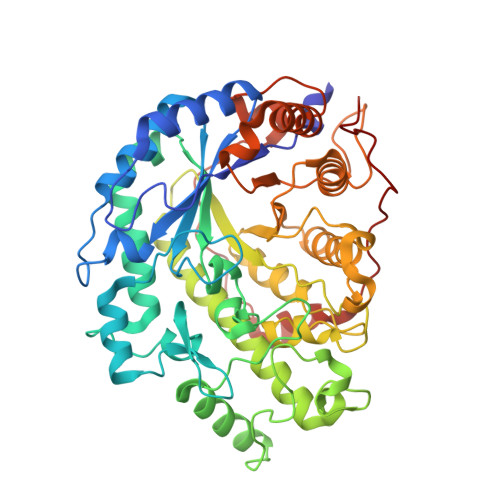The Roles of Glu186 and Glu380 in the Catalytic Reaction of Soybean beta-Amylase.
Kang, Y.N., Adachi, M., Utsumi, S., Mikami, B.(2004) J Mol Biology 339: 1129-1140
- PubMed: 15178253
- DOI: https://doi.org/10.1016/j.jmb.2004.04.029
- Primary Citation of Related Structures:
1V3H, 1V3I - PubMed Abstract:
It has previously been suggested that the glutamic acid residues Glu186 and Glu380 of soybean beta-amylase play critical roles as a general acid and a general base catalyst, respectively. In order to confirm the roles of Glu186 and Glu380, each residue was mutated to a glutamine residue and the crystal structures of the substrate (E186Q/maltopentaose) and product (E380Q/maltose) complexes were determined at resolutions of 1.6 Angstrom and 1.9 Angstrom, respectively. Both mutant enzymes exhibited 16,000- and 37,000-fold decreased activity relative to that of the wild-type enzyme. The crystal structure of the E186Q/maltopentaose complex revealed an unambiguous five-glucose unit at subsites -2 to +3. Two maltose molecules bind on subsites -2 to -1 and +2 to +3 in the E380Q/maltose complex, whereas they bind in tandem to -2 to -1 and +1 to +2 in the wild-type/maltose complex. The conformation of the glucose residue at subsite -1 was identified as a stable (4)C(1) alpha-anomer in the E380Q/maltose complex, whereas a distorted ring conformation was observed in the wild-type/maltose complex. The side-chain movement of Gln380 to the position of a putative attacking water molecule seen in the wild-type enzyme caused the inactivation of the E380Q mutant and an altered binding pattern of maltose molecules. These results confirm the critical roles played by Glu186 in the donation of a proton to the glycosidic oxygen of the substrate, and by Glu380 in the activation of an attacking water molecule. The observed difference between the backbones of E186Q/maltopentaose and E380Q/maltose in terms of Thr342 suggests that the side-chain of Thr342 may stabilize the deprotonated form of Glu186 after the cleavage of the glycosidic bond.
Organizational Affiliation:
Laboratory of Food Quality Design and Development, Graduate School of Agriculture, Kyoto University, Uji, Kyoto 611-0011, Japan.





















